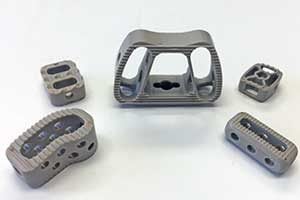PEEK and titanium are the primary biomaterials used in fusion cages, but PEEK has a few decisive advantages over titanium. Recently published research also suggests that the high-performance polymer is a better fit for fusion procedures.
 Though PEEK is one of the newer biomaterials, it has quickly emerged as a top choice in several spinal fusion procedures, including:
Though PEEK is one of the newer biomaterials, it has quickly emerged as a top choice in several spinal fusion procedures, including:
- Anterior cervical discectomy and fusion, or ACDF.
- Anterior lumbar interbody fusion, or ALIF.
- Posterior lumbar interbody fusion, or PLIF.
PEEK is also being considered for other spinal devices, including artificial discs. This makes sense, because PEEK is well-suited to handle the physical demands placed on the spine.
PEEK vs. Titanium: Fusion Rates and Subsidence
Studies comparing titanium and PEEK focus on fusion rates and subsidence. Fusion refers to the implant’s capacity to osseointegrate with native bone and subsidence refers to caving in of nearby bone.
Subsidence occurs as a result of stress shielding, and stress shielding occurs when the bone is no longer stimulated by weight bearing forces. Without this stress, affected bone tissue drops in mineral density, compromising its structure to an extent. A loss of bone mineral density could lead to a higher risk of fractures, as has been noted in studies with osteoporosis patients.
PEEK and titanium cages are similar regarding fusion rates, and the research confirms that there isn’t a statistically significant difference between the two. However, there is a significant difference in subsidence rates.
According to a 2013 study published in the European Spine Journal, titanium cages were associated with much higher rates of subsidence (over 30 percent) compared to PEEK (less than 10 percent). Additional studies, including a 2017 study published in the Journal of Clinical Neuroscience, reinforce this research and have found the same thing.
Subsidence remains a significant concern with titanium implants, but PEEK is much more promising in this area due to its bone-like flexural modulus. PEEK, in its unfilled state, possesses a similar flexural modulus to cortical bone, so it bends and bears weight like the body’s own tissues. This is how PEEK is able to avoid stress shielding, and how the polymer encourages more effective healing in native bone.
PEEK vs. Titanium: Radiolucency
PEEK’s flexural modulus is one of its primary advantages, but it’s not the only one. PEEK, again in its unfilled state, offers pure radiolucency. It is completely invisible on MRIs, CT scans and X-rays, so surgical teams can easily monitor post-operative progress and confirm that osseointegration is taking place. If there is a chance of complications emerging, PEEK’s pure radiolucency allows surgical teams to catch them sooner.
PEEK’s pure radiolucency can be modified with the addition of additives like barium sulfate. When mixed in, barium sulfate adds image contrast to the polymer, without affecting PEEK’s properties.
Titanium, unsurprisingly, doesn’t offer the same radiolucency that PEEK does. Titanium, like other metals, is an image-scattering material and creates significant artifacts. This can interfere with attempts to assess the implant’s position and its fusion progress.
PEEK vs. Titanium: Processability
Both PEEK and titanium cages are manufactured using modern CAM processes, and both to excellent tolerances. Titanium, though, poses difficulties during the machining process as it possesses low thermal conductivity. Both expose machining tools to additional wear, which can make the metal more expensive and more challenging to work with.
In the hands of a skilled converter, though, PEEK can be efficiently machined without compromising its properties. The key word here is “skilled,” because PEEK is vulnerable to subtle issues like fiber orientation. A converter experienced with PEEK will be equipped to sidestep these potential obstacles.
In addition to machining, PEEK can be converted using injection molding and extrusion processes. Medical processing facilities can maximize processing economy by opting for large runs of injected PEEK components. Via extrusion, PEEK can also be converted into durable stretches of medical tubing.
PEEK vs. Titanium: The Future
PEEK is a newer biomaterial, so there is more potential to unlock with the polymer. There are already several advanced PEEK cages on the market, mixed with materials that encourage bone growth and osseointegration. Zeolite and hydroxyapatite are two such materials, and initial research confirms that these new PEEK implants are achieving superior bone-in growth.
New PEEK implants are also designed with microporous structures, and these encourage native bone to grow into the implant, with a lock-like fit. Though there are similar initiatives targeted at titanium, PEEK’s superior processability likely means that there is more room to improve upon the polymer.
In the battle of biomaterials, PEEK offers a superior modulus, better radiolucency and a wider range of processing options. These advantages explain why PEEK is the first choice in spinal fusion procedures, and why it is an important biomaterial for several medical fields.
